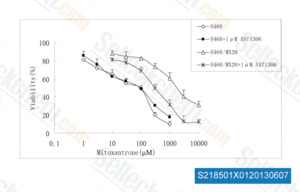|
Toll Free: (877) 796-6397 -- USA and Canada only -- |
Fax: +1-832-582-8590 Orders: +1-832-582-8158 |
Tech Support: +1-832-582-8158 Ext:3 Please provide your Order Number in the email. |
Technical Data
| Formula | C24H18ClFN4O2,C7H8O3S |
||||||
| Molecular Weight | 621.08 | CAS No. | 1050500-29-2 | ||||
| Solubility (25°C)* | In vitro | DMSO | 124 mg/mL (199.65 mM) | ||||
| Water | Insoluble | ||||||
| Ethanol | Insoluble | ||||||
| In vivo (Add solvents to the product individually and in order) |
|
||||||
|
* <1 mg/ml means slightly soluble or insoluble. * Please note that Selleck tests the solubility of all compounds in-house, and the actual solubility may differ slightly from published values. This is normal and is due to slight batch-to-batch variations. * Room temperature shipping (Stability testing shows this product can be shipped without any cooling measures.) |
|||||||
Preparing Stock Solutions
Biological Activity
| Description | Allitinib tosylate (AST-1306 TsOH, AST-6) is a novel irreversible inhibitor of EGFR and ErbB2 with IC50 of 0.5 nM and 3 nM, also effective in mutation EGFR T790M/L858R, more potent to ErbB2-overexpressing cells, 3000-fold selective for ErbB family than other kinases. | ||||||||
|---|---|---|---|---|---|---|---|---|---|
| Targets |
|
||||||||
| In vitro | AST-1306 also ErB2 and EGFR T790M/L858R double mutant. AST-1306 is approximately 500-fold more potent than lapatinib and more than 3000-fold selective for ErbB family kinases over other kinase families including PDGFR, KDR and c-Met. AST-1306 might covalently bind to specific amino acid residues of EGFR and ErbB2. AST-1306 acts in a concentration dependent manner to significantly inhibit the growth of HIH3T3-EGFR T790M/L858R cells. AST-1306 effectively suppresses EGFR phosphorylation in HIH3T3-EGFR T790M/L858R cells. Moreover, AST-1306 blocks the growth of NCI-H1975 cells that harbor the EGFR T790M/L858R mutation in a concentration-dependent manner. AST-1306 blocks phosphorylation of EGFR and downstream pathways as well. In addition, AST-1306 dose-dependently and markedly inhibits EGF-induced EGFR phosphorylation in A549 cells. AST-1306 inhibits the phosphorylation of EGFR and ErbB2, and downstream signaling in human cancer cells including A549 cells, Calu-3 cells and SK-OV-3 cells. [1] | ||||||||
| In vivo | Twice daily oral administration of AST-1306 gives rise to a dramatic prevention of tumor growth in SK-OV-3 and Calu-3 xenograft models. In SK-OV-3 models, tumors nearly disappears after treatment with AST-1306 for 7 days. In contrast, AST-1306 only slightly inhibits the growth of tumor in HO-8910 and A549 xenograft models. Therefore, the antitumor efficacy of AST-1306 is greater in ErbB2-overexpressing tumor models than in models expressing low levels of ErbB2. AST-1306 is well tolerated. Lapatinib displays antitumor activity in these ErbB2-overexpressing tumor models, but AST-1306 is more efficacious than lapatinib in the SK-OV-3 xenograft tumor model when given at the same dose and schedule. In addition, oral administration of AST-1306 twice daily for 3 weeks dramatically suppresses the growth of tumor in the FVB-2/Nneu models. After treatment for 11 days, tumors almost completely disappears. The body weights of the mice reduces by less than 20% during treatment. [1] |
Protocol (from reference)
| Kinase Assay:[1] |
|
|---|---|
| Cell Assay:[1] |
|
| Animal Study:[1] |
|
Customer Product Validation

-
,
Selleck's Allitinib tosylate has been cited by 18 publications
| Establishment and molecular characterization of HCB-541, a novel and aggressive human cutaneous squamous cell carcinoma cell line [ Hum Cell, 2024, 10.1007/s13577-024-01054-1] | PubMed: 38565739 |
| Epiregulin as an Alternative Ligand for Leptin Receptor Alleviates Glucose Intolerance without Change in Obesity [ Cells, 2022, 11(3)425] | PubMed: 35159237 |
| Epiregulin as an Alternative Ligand for Leptin Receptor Alleviates Glucose Intolerance without Change in Obesity [ Cells, 2022, 11(3)425] | PubMed: 35159237 |
| Efficacy of Combined Use of Everolimus and Second-Generation Pan-EGRF Inhibitors in KRAS Mutant Non-Small Cell Lung Cancer Cell Lines [ Int J Mol Sci, 2022, 23(14)7774] | PubMed: 35887120 |
| High ErbB3 Activating Activity in Human Blood Is Not Due to Circulating neuregulin-1 Beta [ Life Sci, 2020, 15;251:117634] | PubMed: 32251632 |
| Betacellulin-Induced α-Cell Proliferation Is Mediated by ErbB3 and ErbB4, and May Contribute to β-Cell Regeneration [ Front Cell Dev Biol, 2020, 8:605110] | PubMed: 33553143 |
| Betacellulin enhances ovarian cancer cell migration by up-regulating Connexin43 via MEK-ERK signaling. [ Cell Signal, 2020, 65:109439] | PubMed: 31654720 |
| Small-Molecule and CRISPR Screening Converge to Reveal Receptor Tyrosine Kinase Dependencies in Pediatric Rhabdoid Tumors. [ Cell Rep, 2019, 28(9):2331-2344] | PubMed: 31461650 |
| LncRNA AFAP1-AS1 Supresses miR-139-5p and Promotes Cell Proliferation and Chemotherapy Resistance of Non-small Cell Lung Cancer by Competitively Upregulating RRM2 [ Front Oncol, 2019, 9:1103] | PubMed: 31696057 |
| ErbB2 promotes endothelial phenotype of human left ventricular epicardial highly proliferative cells (eHiPC) [Ryzhov S J Mol Cell Cardiol, 2018, 115:39-50] | PubMed: 29291395 |
RETURN POLICY
Selleck Chemical’s Unconditional Return Policy ensures a smooth online shopping experience for our customers. If you are in any way unsatisfied with your purchase, you may return any item(s) within 7 days of receiving it. In the event of product quality issues, either protocol related or product related problems, you may return any item(s) within 365 days from the original purchase date. Please follow the instructions below when returning products.
SHIPPING AND STORAGE
Selleck products are transported at room temperature. If you receive the product at room temperature, please rest assured, the Selleck Quality Inspection Department has conducted experiments to verify that the normal temperature placement of one month will not affect the biological activity of powder products. After collecting, please store the product according to the requirements described in the datasheet. Most Selleck products are stable under the recommended conditions.
NOT FOR HUMAN, VETERINARY DIAGNOSTIC OR THERAPEUTIC USE.
